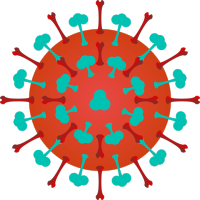| disease | Roundworm |
| alias | Ascariasis |
Ascaris lumbricoides Linnaeus, 1758, commonly known as roundworm, is one of the most common intestinal parasites in humans. Adult worms reside in the small intestine and can cause ascariasis. Additionally, Toxocara canis, commonly known as dog roundworm, is a common intestinal parasite in dogs. Its larvae can migrate within the human body, causing visceral larva migrans (VLM).
bubble_chart Epidemiology
The distribution of roundworms is worldwide, particularly in warm, humid, and poor sanitary conditions where infections are more common. The infection rate of roundworms is higher in rural areas than in urban areas, and higher in children than in adults. Currently, in many rural areas of China, the infection rate remains as high as 60-90%.
Etiology
Ascaris lumbricoides (Linnaeus, 1758), commonly known as roundworm, infects humans through oral ingestion of its eggs at the infectious stage.
Pathological changes
During the larval pathogenic phase, some patients may show infiltrative sexually transmitted disease changes on chest X-rays, with lesions often exhibiting migratory patterns. The adult worm pathogenic phase can cause injury to the intestinal mucosa, urticaria, cutaneous pruritus, angioneurotic edema, conjunctivitis, suppurative cholangitis, cholecystitis, and even lead to bile duct necrosis, perforation, as well as intestinal volvulus and intestinal necrosis.
bubble_chart Clinical Manifestations
1. Pathogenicity during the larval stage: Clinical manifestations may include fever, cough, asthma, bloody sputum, and an increased proportion of eosinophils in the blood.
2. Pathogenicity during the adult stage: a. Patients often exhibit symptoms such as loss of appetite, nausea, vomiting, and intermittent periumbilical pain. b. Symptoms such as urticaria, cutaneous pruritus, angioneurotic edema, and conjunctivitis may occur. c. Sudden onset of colicky pain in the right upper abdomen, radiating to the right shoulder, back, and lower abdomen. The pain is intermittently exacerbated, accompanied by nausea and vomiting.
The diagnosis can be confirmed by detecting eggs in the patient's stool. For patients with clinical manifestations suggestive of ascariasis but no eggs found in stool, a therapeutic diagnosis with anthelmintic treatment may be used, and the morphology of the expelled worms can be examined for identification. For patients suspected of pulmonary ascariasis or allergic pneumonia caused by Ascaris larvae, the diagnosis can be confirmed by examining the sputum for Ascaris larvae.
bubble_chart Treatment MeasuresThe prevention and control of ascariasis should adopt comprehensive measures, including screening and treating patients and carriers, managing feces, controlling water sources, and preventing infection. Strengthening health education, promoting hygiene knowledge, paying attention to dietary and personal hygiene, washing hands before meals and after using the toilet, avoiding raw unwashed vegetables and fruits, and refraining from drinking untreated water can prevent the ingestion of Ascaris eggs and reduce infection opportunities. Using sanitized human feces as fertilizer and preventing fecal contamination of the environment are crucial measures to cut off the transmission route of Ascaris. In areas where liquid manure is used as fertilizer, the five-compartment three-pool fecal storage method can be employed to allow most eggs to settle at the bottom of the pools. Due to the action of free ammonia and anaerobic fermentation in the fecal water, the eggs can be killed while also enhancing fertilizer efficiency. Utilizing biogas fermentation not only provides lighting and cooking fuel for rural households but also facilitates the sanitization of feces. Fecal residue can be cleared every six months, by which time the vast majority of eggs have lost their infectivity. In regions where dry feces are used as fertilizer, the mud-sealed composting method can be applied. After three days, the temperature inside the compost pile can rise to 52°C or higher, effectively killing Ascaris eggs.
Deworming treatment for patients and carriers is a crucial measure to control the source of pestilence. Deworming not only reduces the infection rate and the source of pestilence but also improves the health status of children. The optimal time for deworming is during autumn or winter after the peak infection period, and school-aged children can be treated collectively. Due to the possibility of reinfection, it is advisable to repeat deworming every 3 to 4 months. Patients with complications should be promptly referred to hospitals for diagnosis and treatment, and self-medication should be avoided to prevent worsening the condition.
Common vermifugal medications include albendazole, mebendazole, levamisole, and piperazine citrate (commercially known as Antepar), all of which are highly effective with minimal side effects.
Due to the possibility of reinfection, it is best to deworm every 3 to 4 months.
Strengthen publicity and education, popularize health knowledge, pay attention to dietary hygiene and personal hygiene, wash hands before meals and after using the toilet, avoid eating unwashed vegetables and fruits, do not drink untreated water, prevent ingestion of Ascaris eggs, and reduce the chance of infection.
Using harmless human feces as fertilizer and preventing fecal contamination of the environment are important measures to cut off the transmission route of Ascaris. In areas where liquid manure is used as fertilizer, the five-compartment three-pool fecal storage method can be adopted, allowing most of the eggs in the feces to settle at the bottom of the pool. Due to the action of free ammonia in the fecal water and anaerobic fermentation, the eggs can be killed, while also increasing fertilizer efficiency. Utilizing biogas fermentation not only solves household lighting and cooking needs but also facilitates the harmless treatment of feces. Fecal residue can be cleared approximately every six months. By this time, the vast majority of eggs will have lost their infectivity. In areas where dry feces are used as fertilizer, the mud-sealed composting method can be employed. After three days, the temperature inside the compost pile can rise to 52°C or higher, effectively killing Ascaris eggs.
Biliary ascariasis, ascaris pancreatitis, appendicitis, or ascaris granuloma.







